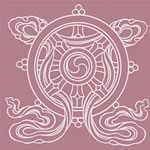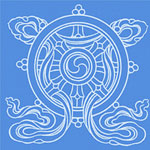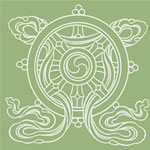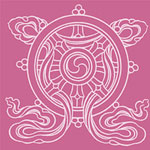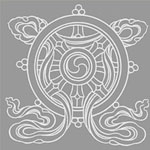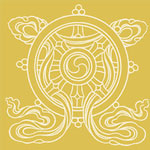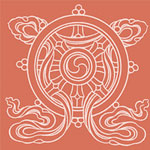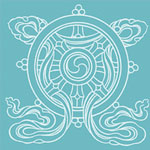The vidyadhara Tukyi Dorje or Dorje Drakpo Trinley Dupa Tsal was an emanation of the dharma king Trisong Detsen. He was recognized as the fourth rebirth of the lord of siddhas Sonam Gyamtso and enthroned at his seat, Dzigar Tashi Choling Monastery. He offered the fruits of his crown to the omniscient Eighth Situpa Chokyi Jungne and received the name Kagyu Trinley Nampar Gyalwe De. He received countless profound dharma teachings from the Eighth Situpa, the omniscient Drukchen, the master ...
Continue Reading →Born to a family of tantric practitioners in Chida in northern Tibet, the Seventh Karmapa, Chodrak Gyatso, dedicated much of his life to retreat. He was also an extremely accomplished scholar, who authored many texts, such as a commentary on Abhisamayalamkara called The Lamp Of The Three Worlds. His most famous text is The Ocean Of Reasoning, his commentary on pramana (logic and reasoning) literature.
The Seventh Karmapa formally established monastic universities at Tsurphu and other places. He also ...
Continue Reading →Vasabandhu resided at Nalanda Monastery at a young age and studied the Foundation Vehicle teachings. He then went to Kashmir where he mastered the philosophies of many different Buddhist and non-Buddhist schools before returning to Magadha and studying the Great Vehicle from his elder brother Asanga. He had thousands of students and was one of the most prolific Buddhist authors in ancient India; many of his works are preserved in the Tibetan Tengyu.
Lama Kathy Wesley (Gyurme Chotso) has been a student of Khenpo Karthar Rinpoche since 1977. Her presence and steadfast outreach work within the KTC network sets an important standard for all practitioners and for women in particular.
Lama Kathy participated in the first three-year retreat led by Khenpo Rinpoche at Karme Ling Retreat Center in upstate New York, and thus earned the title of “retreat lama.” Lama Kathy serves at the Columbus Karma Thegsum Choling in Ohio as its practice coordinator, ...
Continue Reading →Lama Karma Drodhul, born in 1974 in Eastern Tibet, became a monk at Thrangu Monastery at the age of twelve and after attending shedra (monastic college), received full ordination at the age of twenty. He came to the United States in 1997 and has been his uncle, Khenpo Karthar Rinpoche’s attendant since that time. He has completed two three-year retreats under Khenpo Rinpoche and is now coretreat master at the Karme Ling Retreat Center in Delhi, New York. Lama Karma travels ...
Continue Reading →Khakhyap Dorje, the Fifteenth Karmapa (1871-1922), was born with the very auspicious circle of hair between the eyebrows (found on the young Sakyamuni and known as one of the 32 marks of an enlightened being). Khakyab Dorje spoke the mantra of Avalokiteshvara at his birth in the Tsang province in central Tibet and is the first in the line of Karmapas to get married; he had three sons. His life was a brilliant example of the bodhisattva with an insatiable desire for learning in ...
Continue Reading →Ngulchu Thogme Sangpo was born in the year of the wood Sheep (1285) in central Tibet. This great master and true bodhisattva wrote more than one hundred texts clarifying the teachings of the Buddha. He is most known for For the Benefit of All Beings, which is the daily Chenrezik sadhana practiced by many western students.
Continue Reading →Milarepa (1040-1123), the most renowned and accomplished of Tibet’s tantric yogins, was known to have achieved enlightenment in one lifetime. Milarepa received the tradition of the Practice Lineage from Marpa Lotsawa, who underwent great hardship to bring these teachings to Tibet from India. Milarepa was Marpa’s primary dharma heir. Milarepa is most famous for his songs and poems, in which he expresses the profundity of his realization of the dharma with extraordinary clarity and beauty. Many of Milarepa’s poetic compositions have been translated into numerous ...
Continue Reading →Thangtong Gyalpo (1385-1509 or 1361–1485), also known as Chakzampa and Tsondru Zangpo, was a great Buddhist adept, yogi, physician, blacksmith, architect, and a pioneering civil engineer. He composed For the Benefit of All Beings as Vast as the Skies, the Chenrezik sadhana that is a daily practice in many western centers.
He is well known for founding Ache Lhamo, (Tibetan opera), and is famous for his extensive travels in China, Tibet, and other eastern countries, building numerous temples and metal bridges and ...
Continue Reading →Peter Alan Roberts began learning Tibetan at Samye Ling in Scotland in 1976. Since then, he has translated for many Tibetan lamas all over the world. He is renowned for the clarity of translation, and for his humility and rather eccentric sense of humor. The Mind of Mahamudra is his most recent book.
Continue Reading →Ringu Tulku Rinpoche is a Tibetan Buddhist Master of the Kagyu Order. He was trained in all schools of Tibetan Buddhism under many great masters such as the 16th Gyalwang Karmapa and Dilgo Khyentse Rinpoche. He took his formal education at Namgyal Institute of Tibetology, Gangtok and Sampurnananda Sanskrit University, Varanasi, India and has served as Professor of Tibetology in Sikkim for 17 years. His doctoral thesis was on the Ecumenical Movement in Tibet.
Since 1990 he has been traveling and teaching ...
Continue Reading →The Ninth Karmapa Wangchuk Dorje (1556–1603) is best known as the author of Pointing Out the Dharmakaya and other texts on the practice of mahamudra. He also wrote several commentaries on philosophy that are noted for being clear and easy for new students, including this text as well as Feast for the Fortunate, a commentary on madhyamika philosophy. He spent most of his life traveling throughout Tibet in the Great Encampment, practicing meditation, teaching the Dharma, and helping sentient beings ...
Continue Reading →The Ninth Thrangu Rinpoche was born in 1933 in Kham, Tibet and was recognized by the Sixteenth Gyalwang Karmapa and the Eleventh Palpung Situ Rinpoche. Thrangu Rinpoche studied and trained at Thrangu Monastery in Tibet, founded 500 years earlier by the Seventh Karmapa.
Rinpoche, who is one of the Karma Kagyu school’s highest scholars, is a teacher and full holder of the Kagyu Vajrayana lineages and of the direct transmissions of the special shentong philosophical tradition. He is the abbot of Nalanda Institute ...
Continue Reading →Yongey Mingyur Rinpoche was born in Nepal in 1975 and recognized as a tulku by both His Holiness the Sixteenth Karmapa and His Holiness Dilgo Khyentse Rinpoche.
Rinpoche studied mahamudra teachings and the trekcho and togyal aspects of dzogchen at the Nagi Gompa hermitage in Nepal with his father Tulku Urgyen Rinpoche, one of the greatest dzogchen meditation masters of our time. Mingyur Rinpoche was then invited by His Eminence Tai Situ Rinpoche to study the rituals of the Karma Kamtsang ...
Continue Reading →Kyabje Tenga Rinpoche (1932-2012) was recognized as one of the tulkus of the great Benchen Monastery in eastern Tibet. Rinpoche fled Benchen for Lhasa in 1959 and went on to Rumtek Monastery in Sikkim, the seat of the Sixteenth Gyalwang Karmapa, where he served as dorje loppon (vajra master) for more than nine years. Rinpoche first traveled to the West with the Karmapa in 1974 where he taught a three-week seminar on Buddhism every two years in Germany where many of his students ...
Continue Reading →Born into a renowned family of yogic practitioners, Khenpo Sherap Phuntsok has authored several books in Tibetan on philosophy and history. For many years he has taught in the institute for higher Buddhist studies at Thrangu Tashi Yangtse in Nepal.
Continue Reading →Jamgon Mipham (1846-1912) was one of the greatest teachers of his time, and is considered to have been an emanation of Manjushri. His writings remain the basis for much of the study conducted by the Nyingma school of Buddhism, and by other traditions such as the Karma Kagyu.
Mipham embodied the nonsectarian movement of the nineteenth century, and studied with masters of all schools of Tibetan Buddhism. His root guru was the nonsectarian master Jamyang Khyentse Wangpo. His other teachers included both ...
Continue Reading →Jamgon Kongtrul Lodro Taye (1813-1899) is the renowned master of the traditions of accomplishment and learning and one of the most influential Tibetan Buddhist masters of the nineteenth century. A holder of diverse lineages of both the Sarma (New) and Nyingma (Ancient) schools of Buddhism, his writings comprise more than a hundred volumes and still form the basis for much of the meditation practice of several lineages. He was also a terton, an artist, and a skilled physician. His writings ...
Continue Reading →Born to a family of devoted Buddhist practitioners in eastern Tibet, the boy who was to become known as the The First Gyalwang Karmapa, Dusum Khyenpa, was called Gephel as a child. When he was thirty he received teachings from Gampopa, the heart son of the Milarepa, greatest yogi in Tibetan history.
His accomplishment in meditation and the practices transmitted to him by his teachers were greatly enhanced by his own natural compassion. His practice produced rapid results and great accomplishments. All ...
Continue Reading →Chokyi Wangchuk, the Sixth Shamar Rinpoche (1584-c.1635), was recognized at an early age by his principal guru, the Ninth Gyalwang Karmapa, Wangchuk Dorje. Demonstrating swift accomplishment in his training and tremendous proficiency in debate and scholarship, he became one of the most renowned panditas of his era. He traveled and taught extensively throughout Tibet, China, and Nepal, and performed vast activity for the benefit of beings.
Just as the Golden Garland of the Kagyu succession continued with Chokyi Wangchuk himself, he in ...
Continue Reading →Geshe Chekhawa (1102-1176) was a prolific Kadampa Buddhist meditation master who was the author of the celebrated root text, Seven Points of Mind Training, which is an explanation of Buddha’s instructions on training the mind, (lojong in Tibetan).
Continue Reading →Barbara Bash is a calligrapher, illustrator, author, and performance artist. She has written and illustrated many books on natural history for adults and children. She also teaches workshops in illustrated journaling, expressive brush calligraphy, and communication practices.
Her workshops have been presented in Buddhist centers and corporate settings, as well as prisons and mental health facilities, creating a space for everyone to make their mark in the world. For more about Ms. Bash, please visit her website at barbarabash.com.
The great Indian Buddhist Master Atisha (982-1054 AD) was responsible for reintroducing pure Buddhism into Tibet. Although Buddhism had been introduced into Tibet some two hundred years earlier by Padmasambhava and Shantarakshita, Buddhist practice in the country had largely been destroyed during the anti-Buddhist purges of the Tibetan king, Lang Darma (circa 836 AD), a follower of Bön, the pre-Buddhist religion of Tibet. Revered as one of the great figures of classical Buddhism, Atisha was a key figure in the ...
Continue Reading →His Holiness the 14th Dalai Lama, Tenzin Gyatso (July 6, 1935), is the spiritual leader of Tibet. The Dalai Lamas are believed to be manifestations of Chenrezik, the Bodhisattva of Compassion and patron saint of Tibet.
His Holiness the Dalai Lama is a man of peace. In 1989 he was awarded the Nobel Peace Prize for his nonviolent struggle for the liberation of Tibet. He has consistently advocated policies of nonviolence, even in the face of extreme aggression. He also became the first ...
Continue Reading →Yongey Mingyur Dorje Drakpo Nuden Tsal, who was born in the Lhatok region of Kham in 1628, was an extraordinary individual who embodied the wisdom and goodness of his tradition, Tibetan Buddhism, while transcending the status quo of its institutions.
In his early years he had visions of Padmasambhava, Karma Pakshi, Hayagriva, Vajra Varahi, and Mahakala and composed a guru sadhana for Karma Pakshi from a mind treasure received in a pure vision.
On one occasion the Kagyu lineage was severely weakened ...
Continue Reading →The great treasure-revealer and visionary Terchan Barway Dorje (1836-1918) was one of the most important Tibetan Buddhist teachers of his day. A student of many great masters of his time, he was initially associated with Surmang Monastery. He devoted a good portion of his life to reviving the lost teachings of the Barom Kagyu Lineage, and revealed nine volumes of terma or “treasure teachings.” Terchen Barway Dorje was an incarnation of both Yeshe Tsogyal and Nupchen Sangye Yeshe. Toward the end of ...
Continue Reading →The first Karma Chakme (1613-1678) was a very learned and realized Buddhist master who founded the Neydo Kagyu Lineage. He was revered in Tibet for his remarkable qualities and accomplishments. Most notably, he composed the Mountain Dharma Retreat Manual, which is regarded as the definitive text on retreat practice in the Karma Kagyu, Drikung Kagyu, and Nyingma orders of Tibetan Buddhism.
Karma Chakme was known for being a prolific writer and scholar, for his ardent devotion to the practices of Sukhavati, and for being ...
Continue Reading →The Eighth Karmapa, Mikyo Dorje, was one of the most erudite and prolific scholars of the Karma Kagyu lineage of Tibetan Buddhism. Mikyo Dorje was born in eastern Tibet, to a family of devoted yogins, the eighth Karmapa was said to have spoken the words “I am the Karmapa” at birth.
He was one of the most renowned of the Karmapas, a great meditation master as well as a prolific and learned scholar, author of over thirty volumes of work, including very ...
Continue Reading →The great master Gampopa (1084-1161), also known as Dakpo Lhaje, and Rechungpa (1084-1161) were the principal students of Milarepa. Gampopa was prophesized in the sutras by Buddha. He pioneered in establishing the framework of the lineage by unifying Milarepa’s Mahamudra lineage with the stages of the path tradition of the Kadampa lineage. This lineage and tradition is known as the Dakpo Kagyu.
Gampopa had three heart disciples: Düsum Khyenpa, Phakmo Drupa, and Saltong Shogom. Düsum Khyenpa (1110-1193), also known as Khampa ...
Continue Reading →Khenpo Tsultrim Gyamtso Rinpoche, one of the foremost living teachers of the Kagyu tradition of Tibetan Buddhism, is a great scholar and master of meditation who traveled the world teaching in Buddhist centers.
In his late teens and early twenties he trained as a yogin in Tibet with a local yogin known as Zopa Tharchin. He spent his early youth in retreat in the mountains until his teacher told him to study for the benefit of others. A renowned scholar, he excels ...
Khenpo Karthar Rinpoche is renowned and celebrated for his immeasurable devotion that knows no bounds, his unwavering steadfastness in fulfilling the commands of the Karmapa despite horrendous difficulties and obstacles, his attainment in mahamudra, his accomplishments in all monastic arts, his pure ethics and flawless morality, as a brilliant scholar, and as a skilled and inspiring teacher.
Born in eastern Tibet in 1924, Khenpo Karthar Rinpoche is one of the great living masters of the Karma Kagyu tradition. Rinpoche, who received most ...
Continue Reading →The exceptionally skilled Lama Yeshe Gyamtso, is one of the foremost translators of Tibetan Buddhist written and oral teachings.
After completing two traditional three-year retreats under the guidance of Kalu Rinpoche and Lama Norlha, at Kagyu Thubten Choling in Wappingers Falls, New York, he has served as an interpreter for many eminent teachers, including the Seventeenth Gyalwang Karmapa, the Third Jamgon Kongtrul Rinpoche, Kyabje Kalu Rinpoche, Khenpo Karthar Rinpoche, and Mingyur Dorje Rinpoche.
Lama Yeshe’s published translations include Chariot of the Fortunate: The ...
Continue Reading →Motivated by the purest of compassion, the Gyalwang Karmapas have taken rebirth continuously since the eleventh century. The present Seventeenth Gyalwang Karmapa, Ogyen Trinley Dorje, was born in Eastern Tibet in 1985. Seven years later, he was recognized by a letter of prediction and brought to Tsurphu Monastery, the seat of the Karmapas in Tibet. Here, he received a traditional education in practice and philosophy, and at the turn of the millennium, he journeyed over the Himalayas to India where ...
Continue Reading →Khenpo David Karma Choephel studied Buddhist philosophy at the Vajra Vidya Institute in Namo Buddha, Nepal, and Sarnath, India. He currently serves as Khenchen Thrangu Rinpoche’s main English-language translator, and also translates for the Gyalwang Karmapa and the Kagyu Monlam.
His published translations include Ngondro for Our Current Day by the Gyalwang Karmapa, Heart of the Dharma by Khenchen Trangu Rinpoche, Jewels from the Treasury, Vasubandhu’s Verses on the Treasury of Abhidharma, with commentary by the Ninth Karmapa Wangchuk Dorje, all published by ...
Continue Reading →A long-time student of Buddhism and an accomplished translator, Michele Martin has spent many years based in Nepal and India studying with Tibetan lamas and working as a translator of oral and written Tibetan. With graduate degrees from Yale University and years of work as an editor, her publications include numerous translations from Tibetan texts on philosophy and meditation and also articles on Buddhism, including Music in the Sky: The Life, Art, and Teachings of the Seventeenth Karmapa Ogyen Trinley ...
Continue Reading →Traleg Kyabgon Rinpoche (1955-2012) was born in Eastern Tibet and recognized at the age of two by the Sixteenth Gyalwang Karmapa—head of the Karma Kagyu lineage—as the ninth incarnation of the Traleg tulkus. This lineage can be traced back to the time of Saltong Shogam, a contemporary of the First Karmapa Dusum Khyenpa.
Traleg Rinpoche was enthroned as the Abbot of Thrangu Monastery in Tibet before being taken to safety in India following the Chinese invasion of his country. There he continued ...
Continue Reading →Asanga (5th century AD, b. Puruṣapura, India) was an influential Buddhist philosopher who established the Yogacara school of idealism that held that the external world exists only as mental images that have no real permanence. His brother was Vasubandhu who, before he encountered the Mahayana, authored the Abhidharmakosa.
“As so often happens, it is very hard to really grasp or understand what Asanga was like as a person and what events really took place in his life because he lived roughly in the ...
Continue Reading →
